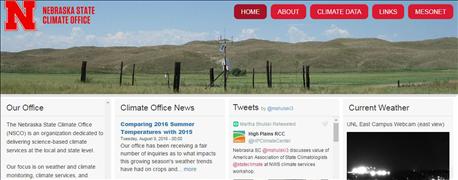September 26, 2016

The Nebraska State Climate Office at University of Nebraska-Lincoln, an organization dedicated to delivering science-based climate services at the local and state level, recently announced the launch of its sister websites.
The sites offer easy-to-read climate data maps for 17 areas of focus, ranging from precipitation totals to growing degree days. Both sites were built using responsive design. Find them at nsco.unl.edu and mesonet.unl.edu.
"We are excited about the launch of the Nebraska State Climate Office websites," says Martha Shulski, NSCO director and state climatologist. "Our goal has always been to deliver science-based weather and climate information so people can make informed local decisions, and with these sites, we have developed the framework to achieve that goal."
The NSCO website makes available real-time data collected automatically through the office's statewide weather network, the Nebraska Mesonet. Data includes air temperature, humidity, wind speed and direction, precipitation, solar radiation, barometric pressure, and soil temperature. These data sets also are used to create the daily Growing Degree Days and Cattle Comfort Index tools.
"We'll update both sites regularly with current news and data sets," Shulski says, noting the weather network's automated feeds will update hourly. The most recent observations appear 15 minutes after the hour, and summary maps of the previous day update daily at 4 a.m.
"One of the key features that our clients wanted to see is observations in near real-time, so we focused on this aspect for the first round of products," Shulski adds. "We look forward to adding more functionality as new products and summaries are developed."
The launch of the website will help the office continue to answer and meet user requests from across the state. The office annually fulfills 350 data, 250 media and 50 presentation requests. It also provides a short-term weather outlook for Market Journal, based out of Nebraska, and Lexington-based radio station KRVN.
Additionally, office staff contributes to the U.S. Drought Monitor and biweekly Nebraska Extension agricultural updates.
Source: UNL CropWatch
You May Also Like




